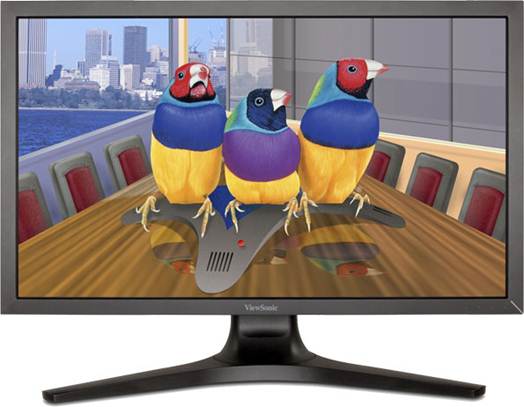ViewSonic’s VP2770-LED is very much an
upmarket monitor, even if it’s not aimed at the silly money graphic arts set.
It’s a 27m iPS screen with 2560 x 1440 resolution, meaning it has 20% more
workspace than a typical 1920 x 1080 panel.
While text can look rather jagged on a 1920
x 1080 screen this large, things are much smoother at the VP2770-LED’s
resolution. The abundance of pixels also means it’s simple to work on two
documents side by side, and it’s perfect for using applications with multiple
toolbars and windows.

ViewSonic
VP2770-LED
There are VGA, DVI, HDMI and display-Port
inputs, so a Mini displayport adaptor is the natural way to hook up to your
Mac. It also has a built-in hub with two USB and two USB 3 ports. The screen is
also highly adjustable: you can use it in portrait and landscape modes, tilt it
towards or away from you, or pivot it from left to right. Further, you can
raise the base of the screen from 88mm all the way to 242mm, so you should be
able to get comfortable no matter how tall you are. The only real drawback of
the design is that the three-legged stand measures an enormous 518 x 418mm from
leg tip to leg tip, so takes up an awful lot of your desk.

While
text can look rather jagged on a 1920 x 1080 screen this large, things are much
smoother at the VP2770-LED’s resolution.
We were initially disappointed with the
results of our calibration tests. Out of the box, the VP2770-LED only came
within 93% of the sRGB colour gamut, and the colour gamut diagram generated by
our dispcalGUl calibration software showed the monitor struggling at its native
Natural settings to display enough red and green to satisfy the sRGB standard.
The display also has an sRGB mode, but this
was much too dark, and there’s no way to change the brightness level when the
screen is set to sRGB. however, once we set the screen to User mode and ran our
calibration process using a Spyder4Express colorimeter, the software reported a
much-improved 99% of sRGB colour gamut.

We
were initially disappointed with the results of our calibration tests.
When viewing our test images, we struggled
to find fault with the ‘P2770-LED. Large areas of colour were vibrant and
uniform across the display, and it showed all the detail we could hope for in
both light and dark areas of our test pictures. Better still, the screen’s matt
finish also means it hardly suffers from reflections from overhead light
sources.
ViewSonic’s VP2770-LED is a feature packed
and highly adjustable monitor, with superb picture quality once you’ve
calibrated it. It doesn’t have the best colour accuracy out of the box, so we’d
recommend you invest in a colour calibrator, but if you’re prepared to do this,
it’s a great buy. However, if you can do without the USB hub and screen pivot
and want better colour accuracy out of the box, we’d recommend saving $150 and
buying the Asus PB278Q.